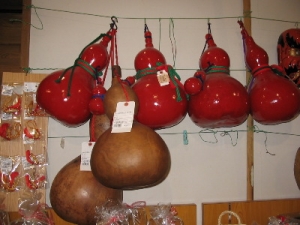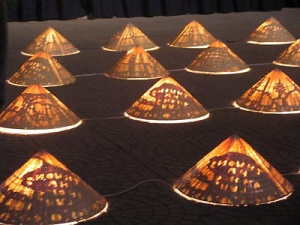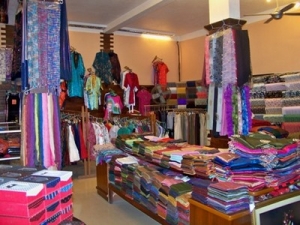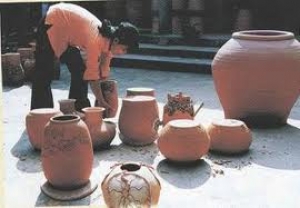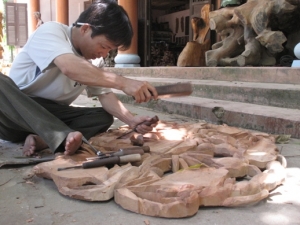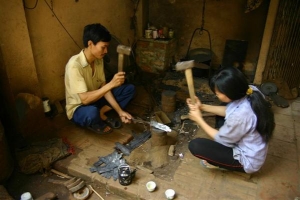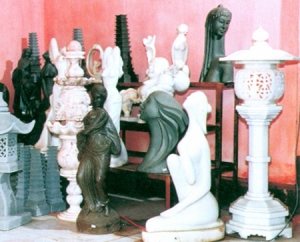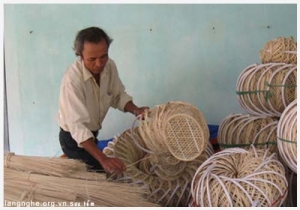
Asia Pacific Travel Team
The gourd life
What can make music, hold water and inspire dozens or legends in Vietnam`s Central Highlands, the gourd is a godsend.
The myth
The bottle-gourd is among the first plants to have been cultivated in Southeast Asia. Many ethnic groups in the region recount myths that tell o humankind`s rebirth from a magic gourd, following a great flood that covered the world. While this myth is absent among the minority peoples of Vietnam`s Tay Nguyen (Central Highlands), the bottle-gourd plays an important role in the lives of many Highlanders.
The gourds used to make jars are bitter ones, different from the varieties that are eaten. According to a Sedang legend, there once lived a woman named Lady Croa, who was ordered to gather all of the edible gourds in the world. At that time, the earth was covered in gourds, and the lady was furious at having been assigned such a time-consuming task. She spread her breast milk on the young gourds and cursed them, after which they became too bitter to eat.
Using gourd
A bottle-gourd is shaped like two balls, a smaller one sitting atop of a larger one. When selecting gourds, people choose ones with symmetrical shapes.
In the Tay Nguyen, it is the women who sow the gourd seeds in mountain fields and process the hardened shells. When the gourds are ripe, they discard the seeds and pulp and dry the shells, which are then soaked in water. Soot and mud are rubbed onto the shells to darken them. After this, the women rub the shells with special leaves and bark. Once or twice a day for several days they polish the gourds, creating a shiny black finish that is extraordinarily durable.
Once processed, the gourds have many uses. Many traditional musical instruments employ bottle-gourds as resonators, including the brook and brang lutes of the Sedang, the goong lute and ding buot klut flute of the Ede, and the kmboat mouth organ and bre flute of the Ma. Some instruments have two gourd resonators, such as the ting ning lute of the Bahnar.
On a more practical level, bottle-gourds make fine containers. They are commonly used to store seeds, tobacco, rice, wine, and water. The Sedang of Kon Turn province claim that Highlanders once survived largely on gourds. According to legend, some wild forest dogs became tangled in the vines and urinated over the gourds, causing the gourds to become inedible.
In the Tay Nguyen, women are responsible for collecting water, whether from springs, mountain streams, or bamboo aqueducts. Every morning and evening the women carry their bottle-gourds to a water source. Each person also has his or her own water flask, carried on outings into the forest or to the swidden fields.
Flasks made from bottle-gourds are light, durable and able to keep water cool. While some highlanders use lo o bamboo tubes to store water for cooking and cleaning, drinking water is kept in gourds.
According to highland beliefs, there is a strong connection between women and gourds. The wooden statues around tomb houses in Giarai and Bahnar cemeteries include depictions of women (never men) holding water-gourds.
According to an Ede legend, there once lived a young man named Y Wing, who created the first ding nam mouth organ from six bamboo tubes, a gourd and some beeswax. Y Wing explained that the six bamboo tubes are siblings, while the gourd and the beeswax are mother and father.
The gourd hold the essence of traditional highland life
For people living in Vietnam`s remote Central Highlands, the bottle-gourd is both a useful object and a cultural symbol. While some highland communities now use vessels of glass and plastic, the gourd has not yet been replaced. Along with their mundane uses, these gourds hold the essence of traditional highland life.
Conical hats in former imperial Hue City
Hat-making village Phu Cam (also Phuoc Vinh) lies on the southern bank of the An Cuu River in the centre of the former imperial capital of Hue. It`s a village famous for its traditional way of making conical hats for hundreds of years.
Phu Cam-made hats look graceful, soft and thin as silk. Hue landscapes or even poems can be seen clearly through the hats in the sunshine. It takes woman much time to make the frame and iron leaves before young girls start sewing. The beauty and grace of a hat depend much on the frame (made of 16 brims from the hem to the top). Artisans use sharp knives to prepare the brims and make the frame that needs skills, techniques and experiences, as well as mathematical calculations which have been handed down for generations.
Leaves to make hat play a vital part, leaves have to be blue-white, neither too young nor too old. Collected leaves are to be put to dry in the sun, put to be moistened by dewdrops, and then to be ironed flat on a steel- plank above a kiln, cleaned with a towel. After all this, leaves are cut to fit the frame.
How to arrange the leaves on to the frame is not easy. Each hat needs 50 leaves and between the leaves are coloured papers with pictures or paintings of landscapes, or even poems. Hat-makers are hardworking, careful, and diligent. Hats are served with silk-threads and the chin-straps are made of coloured silk (black, white, yellowish, purple, violet...) to harmonize with Hue climate and beauty.
Poem-hat is a distinctive feature of culture in Hue. Locals say they like to do the job not only to earn money but to preserve their age-old tradition as poem-hats have been absorbed into folk music and songs. Today hats are still used by young girls to shade their heads in the sun and to make them look more graceful in the traditional Ao Dai (long dress).
Chuong village
If you are lucky enough to arrive at Chuong village on market day, you will happen upon a wonderful scene, the village`s market ground covered with thousands of conical palm hats, known in Vietnamese as non.
On days that end with zero and four in the lunar calendar, merchants from many provinces gather here to buy stacks of Non, which they then distribute throughout the North of Vietnam.
This small village of Ha Tay Province, 40 kilometres on the west of Hanoi, has maintained its reputation for over three centuries. Just like Van Phuc villagers with their fine silks, Cu Da villagers with their soy sauce, Chuong people have their own pride for the famous Non.
If you look at a hat, it seems that it is easily to make. It is wrong! To make a proper hat it is not only required the maker`s talent but also their experience. Bamboo cataphyll must be split into very thin strings during the dry season. They then must be quickly submerged in water to preclude tearing and breaking. Main rings (the largest) must be even, smooth and shiny. The most sophisticated work is treading the palm material. The makers buy dark green palms, then clean them by sand and work them with a light touch or otherwhile they will tear. After the step of treading the palms, they sun-season them. The palm will go from dark green to white. The stronger the sun the whiter the palms will become. Before using the palms, makers expose them briefly to sulfur to make them whiter and to preserve the color. Finally, before using them, they are exposed to frost to make them soft, then they are split and ironed. From the palms and ring, using silk thread, you only to have to sew it together. It is easy to say than to do. Sewing and decorating are very sophisticated too. You have to sew small and even stitches what mean you need time and have to be very patience. For professional purposes, Chuong hat-makers do not accomplish all the stages but specialize - building upon a frame made somewhere else. The local hat-makers complete the hats with an aesthetic appeal suitable to customer`s taste.
Chuong hats are different from hats of other provinces which are revolved only two times, with the second being in a reverse direction, Chuong village`s hats are revolved three times, two times with white palm and once with bamboo cataphyll. Thank to the addition layer of bamboo cataphyll, Chuong hats are more solid and durable. Show them what revolve mean.
Since the first images of Non were etched into Ngoc Lu bronzes drums 3000 years ago, it has become an inseparable multi-purpose item for Vietnamese women. It is used as a shield to protect them from sun and rain, a glass to get water when they are thirsty, a fan when they are hot, and a basket when they have nothing else with them to carry things.
Due to its popularity, each region in Vietnam has, for itself, a well-known non-making village. The non of the Tay ethnic group has a distinctive red colour, while Non in Thanh Hoa differs from others with its 20-hem frame. Hue`s Non is thin and elegant, in contrast with the thickness of those from Binh Dinh.
Chuong artisans make two types of Non: the traditional flat-top, known as Non quai thao, and the cone-shaped Xuan Kieu that appeared in the 1930`s.
Women in the village learn to make Non since as teenagers. Anywhere and anytime, you can find them wrapped up in their work, stitching the white palm leaves.
"Non making is work of painstaking precision", said 83 year-old Le Thi Viet, the oldest master of Chuong village.
Palm leaves, the raw material of Non are bought from Thanh Hoa and Quang Binh in the Central region, or Phu Tho and Son La in the North. After being sun dried, the leaves are flattened by hand, and then ironed with a hot ploughshare until they turn absolutely white.
The skeleton of Non is formed by round bamboo hems. A Chuong village Non always has 16 hems, to make it firm and easily identified among others.
It is said by another 90 year-old artisan that in the past Chuong village produced three types of the hats; Non ba tam, Non nho and Non dau. The classic Non was large and flat, with a small hummock in the centre that fits the head.
Vietnamese women used to wear the traditional three-tailed or seven-tailed dress. The tails come in various tints: they may have the colour of a peach blossom, a day-lily flower, a Tonkin bunch, or a lemon.
In the old days, Non quai thao were sported with a pair of buffalo-leather bow shoes or painted wooden clogs. A light pink or yellow belt makes a perfect match during festivals.
In the late half of 20th century, the flat-top hat was gradually replaced by the cone-shape, just as change has affected the basic ingredient; the palm leave. A new material, lui leaves from Nghe Tinh and Quang Binh province, make each Non Chuong lighter, and therefore more elegant.
Non are no longer built from the ground up by the tinkers of Chuong village. The process is divided into several phases, and the less important parts, such as skeletons and edges, are now farmed out to nearby villages. Todays Chuong artisans only undertake the roofing and sewing.
Such specialisation, however, may be a little misplaced, as women of modern times find Non less than practical for day to day life in the urban environment.
But the little girls of Chuong village are still sewing Non, and the hearth of the Non will always be warm.
Vietnamese Silk - a national treasure
Van Phuc is situated on the bank of Nhue River, 10km from Hanoi on the southwest motorway. The village is in the centre of Ha Dong Town, Ha Tay Province, and the biggest silk production village in Vietnam. The sound of looms has filled Van Phuc for a thousand years, and is a touching sound to villagers when returning from far away.
The main road is surrounded by greenery and ponds, and colourful bolts of silk drying on the road. In fact, the village`s fine silk, commonly known as Ha Dong Silk, has inspired many poets and composers to write about its beauty.
The village is busy with activity and one can hear the sound of the newer power-looms in every home. The days of working strenuously with traditional, manual looms are gone, and the village`s weavers each operate three large power-looms with a small electric motor.
Design of Ha Dong silk patterns has been computerized, which allows designers to reduce working time from 20 days to a just three days per pattern.
Following stories of Van Phuc artisans, the first Vietnamese silk maker was Princess Hoang Phu Thieu Hoa, also known as Mo Nham. Daughter of King Hung Dinh Vuong - King of the first Dynasty of Vietnam - she lived over 3000 years ago.
Thieu Hoa liked weaving, and she often travelled outside the palace to teach people to farm silkworms and the fine art of weaving. When Thieu Hoa reached the age to marry, her father wanted to marry her to a teacher. Thieu Hoa asked the King to delay the wedding and moved to Co Sat village to live, and there she taught people to weave while she worked as a farmer.
As a 32-year-old, she travelled the country to teach the arts of silk in more than 60 villages. She then returned to Co Sat, where she lived out her days.
The most famous Van Phuc product is lua van, van means cloud in Chinese, since lua van billows like a cloud. The village artisans drew the idea to make lua van from flowers and the clouds the jet over bamboo thickets in the summer sky. Producing lua van is a demonstration of the skill of a silk weaver.
Van Phuc, now has 730 households with 1,600 people earning a living by weaving silk. The village stocks a wide variety of silk products, and ships goods all over Vietnam, as well as exported overseas.
Customers can buy silk suited to their wallet. Fabric made of 50% silk sells for an average of VND20,000 per meter, 75% silk for VND50,000, while 100% silk is priced depending on the quality of pattern and fabric thickness.
Statistics show that 785 of all 1,343 households in Van Phuc commune take part in the craft. Silk sales generate about VND27bil and make up 63% of the commune`s economy each year.
Given that each power-loom generates one weaving job (not including supplementary jobs such as spinning, dyeing and yarn joining), the craft village can create more than 1,000 jobs each year.
Huong Canh Pottery Village
The village is situated on the side of National Highway Two, about one hour drive from Hanoi to the north. It is in Binh Xuyen District and according to some historical records; it is about 300 years old. Yet archeological excavated pieces of ceramics found in the village are dating back about a thousand years. The villagers made vases for keeping rice, maize and other grain crops and later on, producing vases for storing water as well as pots for making tea and cooking utensils and coffins for reburial. These products have unique colors of grayish blue, brown and yellow. Several households from Huong Canh Village had used new technology in their production to produce fine arts ceramics products for Tam Dao resort in 2001 with the assistance from the provincial department of science, technology and the environment. The products became popular among tourists and foreign visitors and many orders were made for the products.
Bich Chu Carpentry Village
Bich Chu Village lies on the bank of the Red River running through Vinh Tuong District. The village is famous for its carpentry works and Bich Chu villagers were seen going to different localities with saws and chisels to make furniture.
Their skills match those from famous localities for carpentry in Vietnam such as Son Tay and Nam Dinh. All of the village's 800 households are engaging in carpentry trade. The villagers produce not only common household wood furniture, but also fine art wood furniture and statues and other woodcuts for worshiping with sophisticated traditional decorations.
Bich Chu wooden furniture is famous not only in the province but also in other localities and the village's products are found in many luxurious furniture shops in Hanoi.
Ly Nhan Blacksmith Village
Nobody knows when and how the blacksmith trade started in Ly Nhan Village. Old people told a story of a duke coming to the village for a visit only to find that most the villagers were either drunk or busy gambling most of the years except for the harvests. He advised the villagers to drop the bad habits. He established a workshop and recruited skilled blacksmiths from other localities to come and help the villagers learn a new trade. The villagers learned new trades and kept the trade until today, still producing working tools for agriculture production.
Nearly every household in Ly Nhan Village, Vinh Tuong district engages in blacksmith trade. Knives, scissors, sickles, chisels and other cutting tools made by the villagers are well-known in many localities thanks to beautiful designs and premium quality of tempered steel. The villagers even made weapons during the wars. The village exported 100,000 knives to Cuba in 1962 for cutting sugarcane.
The villagers of Ly Nhan are now teaming up to take the increasing competition of the market. Workshops of several households are established with the use of tooling machines to reduce the workload of human being. The trade is now flourishing in the village.
Hai Luu Stone Carving Village
Hai Luu Village is in Lap Thach District and the stone carving trade has been established there for several hundred years.
Major products of the village are household stone products including stone rice mortar, food mortar, powder grinder as well as pillar stones for houses, communal houses and pagodas. The village artisans also carve stone turtles, pillars, statues and stele.
The tools used in stone carving at the village are simple, including wooden hammers, steel hammers, chisels, stackers and a compass. The stone materials are taken from the Dong Tram, Dong Tro and Nui Thet Mountain. As many as 85% of the villagers know how to carve a stone.
Hai Luu stone carving products were sold widely in the Red River delta in the past. The village now exports their products to the world market.
Vinh Ba Weaving Village
Located in the southwest of Hoa Dong commune, Tuy Hoa district. In this place, there is the famous weaving occupation passed through many generations.
Therefore, bamboos have grown in Vinh Ba village since a very long time ago, bamboos like a dense forest surrounded all the paths so they were called Forest Hamlet, Path Hamlet (or Passage hamlet). Walking through the village roads and hamlet paths in Vinh Ba, products made of bamboos like high baskets, low baskets, large flat winnowing baskets, rice sieves, flower baskets, flower frames, bamboo bags . . . can be seen everywhere.
These products have their markets not only in Phu Yen but in remote provinces in Southern Viet Nam as well.
The Pottery Village
Xom Go village (its former name was Pottery – Kiln Village) belongs to the areas of Hoa Quang and Hoa Tri communes, Phu Hoa district.
According to the old people in the village, this is the oldest pottery village in Phu Yen. From the material resource of clay, the handy craftsman cleverly gives different shapes to the products, then dry them and after that put them into kilns.
Pottery products made in Xom Go village are of variety and diversity, simple but original features are contained in each type and shape such as : water jars, cylindrical earthenware jars, plant pots, earthen pots . . . especially every year on lunar January 9th the whole Xom Go village holds their profession – starting ceremony at the beginning of the year, this is the original cultural activity feature of the local people here, attracting their relatives and friends from afar to attend.


